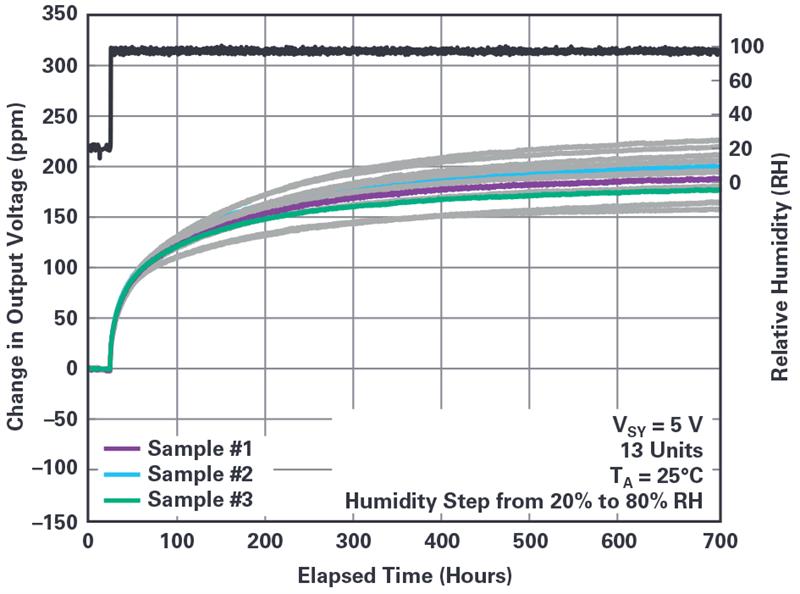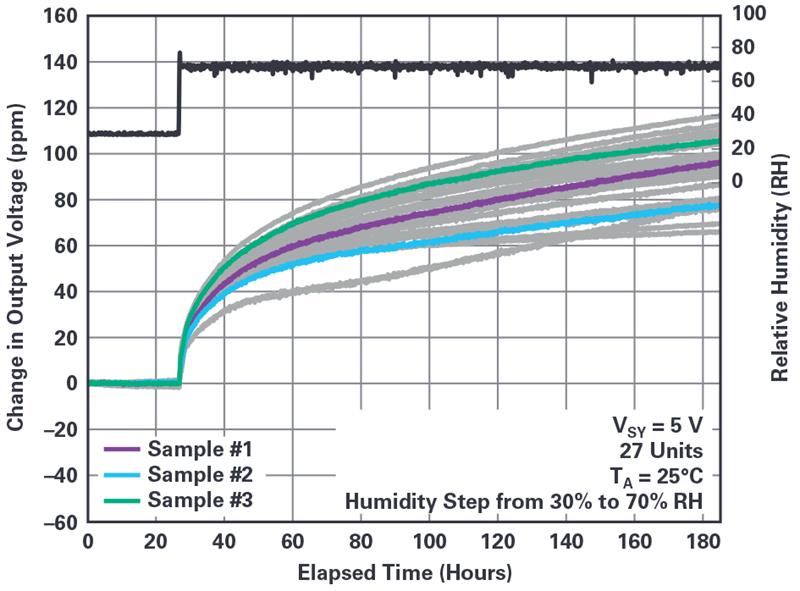Voltage references serve a crucial role in precision analogue systems, often setting the noise/resolution floor within an analogue-to-digital converter (ADC) for precision measurement systems. For the design engineer, the specifications and options for packaging can involve many design pitfalls that could easily undermine the µV or nV accuracy noise target they want to achieve.
How does the engineer protect against damaging environmental effects while preserving analogue performance?
Environmental factors like moisture and temperature can affect electronic performance. Temperature causes mechanical stress due to the different thermal expansion coefficients of the materials that make up the package and the board.
Moisture causes mechanical stress since both the plastic and the board absorb moisture, causing them to expand. The results of environmentally induced mechanical stress often take the form of increased drift over temperature/time in the case of plastic-packaged voltage references, or the form of increased offsets in plastic-packaged MEMS accelerometers.
For plastic packages, the mechanical stress created by humidity is significant, and one way to manage this humidity effect is to package integrated circuits in ceramic or hermetically sealed packages, however, this comes with the additional cost of a premium package, and often a larger sized component.
Conformal coating options
Another method to isolate these stresses is to use a conformal coating in the PCB manufacturing process so that any mechanical stress at the board level translates into less stress at the voltage reference.
A thin layer of a coating compound across the voltage reference and corresponding PCB ensures that any stresses induced through moisture or temperature applied to the PCB don’t translate to a differential stress to the voltage reference chip package and induce offsets. This also ensures that humidity from condensation due to cold temperatures has less effect on humidity ingress into the package.
A variety of conformal coatings that include acrylics, urethanes, silicones, epoxies, and water-based coatings are available for the protection of sensitive devices in PCB manufacturing. One of the parameters is called moisture vapor permeability (MVP), which is the rate at which moisture vapor passes through a coating.
The test method for MVP is to take a dry cup with the respective coating applied, put it into a temperature chamber and then periodically weigh the cup to assess how much moisture is traveling through the material and into the dry cup.
Examining the table yields an important insight - in all cases (with the exception of a very thick UV-cured coating material called UV40), all of these coatings allow some amount of vapor through the coating over time. This is measured in the weight of water that permeates the coating through a given surface area in a given period of time.
While the popular 1A33 coating, a polyurethane coating, is simple to apply it is more than 10 times less effective at slowing down the rate of water vapor absorption than the rubber-based 1B51 coating. The key message here, though, is that none of these coatings provide complete blockage against humidity.
It’s useful to understand the environment in which the electronics will be deployed. Will the exposed electronics only experience short periods of high water vapor? Will the packaging/container of the electronics block water vapour? Does the environment of the electronics change so frequently that the purpose of the conformal coating is simply to block fast changes in the electronics? All are important for the product owner to consider before embarking on a conformal coating path.
Conformal coatings can, in some cases, increase mechanical stress problems because the coating, if improperly applied, can add stress to the package. For instance, if in the PCB manufacture stage, the surface of the voltage reference package has moisture on it prior to coating, it will migrate into the hydrophilic plastic package. So keep surfaces free of moisture, dirt, wax, grease, flux residues, and all other contaminants.
Does it hold water?
Analog Devices has produced a set of test boards to test coatings. Each board has 27 of the same high performance voltage references soldered to the PCB using the recommended J-STD-020 reflow profile. The boards are placed in a humidity chamber and measured using a Keysight 3458A 8.5 digit digital multimeter (002 model) that achieves a 4 ppm/year drift by using the LTZ1000. The chamber is maintained at a constant temperature and humidity while the boards are allowed to settle. The boards sit in the chamber for up to a week before the humidity step is applied while keeping the temperature constant.
Two different conformal coating processes were used on the plasticpackaged voltage references to assess the effect of humidity in the presence of the coatings.
Using the ceramic packaged ADR4525 as a baseline (Figure 1) establishes that 100 hours of being subjected to 70% humidity shows a change in the voltage output of ~3 ppm, or 0.075 ppm/% RH, which is an excellent level of stability. The initial peak in the data is due to a jump in temperature that is caused by the sudden shift in humidity. The humidity chamber slowly recovers the temperature back to 25°C, as can be seen in the data.
In contrast, the same voltage reference die when placed in plastic packages in the same environment and test conditions shows a voltage output change of ~150 ppm, as shown in Figure 2. Normalising the data from Figure 2 (below) with a 60% RH shift shows that the output drifts at ~2.5 ppm/% RH with no conformal coating applied. It also looks apparent that the drift hasn’t completely settled out after 168 hours of soaking the boards in the high humidity environment.
Figure 2: The ADR4525 voltage reference in a plastic package when subjected to a humidity step of 20% to 80%

The HumiSeal 1B73 acrylic coating was tested next and the data is shown in Figure 3 (below). The application procedure consisted of first washing and baking the board (submerge the boards quickly a few times into 75% isopropyl alcohol and 25% deionized water, lightly hand brush, then bake at 150°F for 2 hours), and then spraying the 1B73 coating to the specified thickness. The entire board was coated with the exception of the edge connector, which is required to be clean to enable measurement of the output voltage.
Figure 3: ADR45xx voltage reference coated with HumiSeal 1B73 acrylic coating using a spray application

While the oven used in this test limited the humidity stress to 70% RH, the normalised drift looks like ~100 ppm/40% RH or 2.5 ppm/% RH, which isn’t that different from the drift with no coating applied.
It’s possible that the coating didn’t fully adhere to the underside of the voltage reference package along with the edges of the parts as well. It’s also useful to note here that the ~168 hours of testing under the high humidity may still not be long enough as the voltage reference looks like it hasn’t fully stabilized yet, similar to the uncoated parts.
However, it is useful to see that the humidity effect does appear to have been slowed down in rate of change, at least at the initial time step, which lends credence to the concept of the moisture vapor permeability rate, where the coating isn’t stopping the moisture, but is instead slowing it down.
Another test tried the same conformal coating (HumiSeal 1B73) but with a three-step application process that used a dip coating process to better ensure complete coverage of the board.
Issues with the oven prevented more than 96 hours of testing for this test. Normalising the data set for a 30% RH to 70% RH step shows ~90 ppm or 2.3 ppm/% RH, which is not the massive improvement that was hoped for with this application process, but a slight improvement over the spray coating - although it’s fair to say that if left for a longer test, this slight improvement may disappear.
Future testing could include other types of conformal coatings and crosssection analysis. In short, the data from these experiments show that the ceramic hermetically sealed package is the single best defence against humidity ingress.
Conclusion
In a design that is only targeting 10 bits of accuracy there is a lot of room for hiding inaccuracies, but if your precision instrumentation system is targeting 16 bits and even 24 bits of accuracy, it’s imperative to look at a whole system design, including PCB manufacture, to ensure complete accuracy over the life cycle of your design.
To ensure humidity performance is to use hermetic packages like ceramic, and that conformal coatings can slow down the humidity effects within precision analogue electronics.
As designs move through to manufacture, it becomes necessary to leverage skills outside of electronics, consulting with coatings companies to get the absolute best performance in challenging environments. While following best practices will ensure that your voltage reference won’t hold water, it will help to deliver the performance you need.
About the authors
Paul Perrault is a senior staff field applications engineer at Analog Devices. His experience over the last 17 years at Analog Devices varies from designing 100+ amp power supplies for CPUs to designing nA-level sensor nodes and all current levels in between.
Robert Kiely is a staff applications and marketing engineer at Analog Devices in the Instrumentation and Precision Technology Group in Santa Clara, Califonia. He joined Analog Devices in 2010. Rob’s focus is in precision signal chains and products including Σ-Δ ADCs, precision amplifiers, and voltage references.













